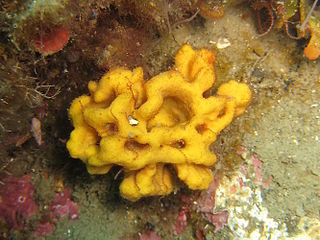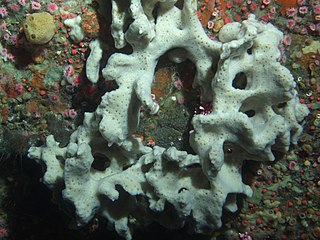
Cladorhiza is a genus of carnivorous sponges, comprising around 40 species found in oceans around the world. Cladorhiza is the type genus of the family Cladorhizidae.

Geodia is a genus of sea sponge belonging to the family Geodiidae. It is the type genus of its taxonomic family.

Halichondria is a genus of sea sponges belonging to the family Halichondriidae. These are massive, amorphous sponges with clearly separated inner and outer skeletons consisting of bundles of spicules arranged in a seemingly random pattern.

Plakinidae is a family of marine sponges. It is composed of seven genera:

Axinella is a genus of sponges in the family Axinellidae first described in 1862 by Eduard Oscar Schmidt. Species of Axinella occur in the Indian and Pacific Oceans. Most of these sponges are smaller than 20 cm, and have a yellow or orange colour.

Stelletta is a genus of sea sponges belonging to the family Ancorinidae.

Tethya is a genus of sea sponges belonging to the family Tethyidae. Members of this genus all have a spherical body form and some are known to be able to move at speeds of between 1 and 4 mm per day.

Clathria is a large genus of demosponges in the family Microcionidae.
Isodictya is a genus of marine demosponge in the family Isodictyidae.

Haliclona is a genus of demosponges in the family Chalinidae.

Ircinia is a genus of sea sponges in the family Irciniidae.

Myxilla is a genus of demosponge belonging to the family Myxillidae. These sponges usually form encrustations on rock surfaces.

Crella is a genus of marine demosponges in the family Crellidae.

Craniella is a genus of marine sponges in the family Tetillidae.

Clathria (Clathria) is a subgenus of demosponge in the family Microcionidae.

Mycale is a genus of demosponge with 240 recognised species in 11 subgenera. It has been a large genus with multiple subdivisions since it was first described in 1867.
Ciocalypta is a genus of sea sponges belonging to the family Halichondriidae.

Phakellia is a genus of sponges belonging to the family Bubaridae. The genus has a cosmopolitan distribution.

Phorbas is a genus of demosponges belonging to the family Hymedesmiidae.
















